| Back to Back Issues Page | |||
 |
|||
|
What do YOU dance for? The Dance Thinker, Issue #32 November 02, 2023 |
|||
| Hi there! The Dance Thinker Issue # 32, November 2, 2023
Dear colleagues! Today’s question is about the purpose of dance. I’m sharing some translations of a dance research made by the Colombian artist ‘Karo Colibrí’. During her work, she interviewed dancers from the ancestral cultures still living in Colombia, which are survivors of the modern colonization. One of the questions asked was: what do you dance for? ... The replies are amazing…! Find it all in the article below:
WHAT DO YOU DANCE FOR? An approximation to Abyayala’s (America’s) ancestral wisdom by Karo Colibrí (Carolina Bejarano).
We have a chat in the forum that may be a good contrasting topic to reflect about today's article: Ballet cultural values and ideas.
https://www.contemporary-dance.org/The_Dance_Thinker-what-do-you-dance-for.html
We have: - A page for contemporary dance announcements in which you can post your news about workshops, auditions, performances, meetings or any current, related items (it's free). - A contemporary dance blog where you can find important updated information and that will automatically distribute what you post in the announcements page to facebook, twitter and all subscribers to the site’s RSS feed. - A worldwide contemporary dance directory of schools, companies, scholarships, festivals and related websites to which you can also submit your contact information. - A forum for asking dance questions. - Several pages in which you can participate with contributions like articles, reviews, questions, or comments. - An archive for THE DANCE THINKER back issues, where you can always revisit precedent issues from our e-zine. - A contact page through which you can address me directly if you have questions, ideas, wishes, suggestions or comments.
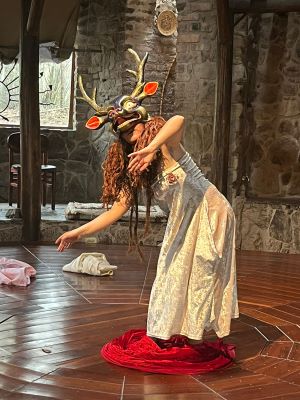 This year I had the privilege of witnessing a dance research made by the Colombian artist Karo Colibrí. She asked herself how to create a decolonized dance to identify submission and subjugation habits in herself.
The project took her to search and deepen into the cosmovision of the indigenous Colombian ancestors (survivors of the modern colonization), which is related and connected to the cosmovision of the humans and cultures throughout the whole American continent, called by them Abyayala (not America), which means ‘land of vital blood in full maturity’.
Among Carolina’s various techniques for data collection, she interviewed people from eleven Colombian indigenous groups and one of her main questions was: What do you dance for?
This year I had the privilege of witnessing a dance research made by the Colombian artist Karo Colibrí. She asked herself how to create a decolonized dance to identify submission and subjugation habits in herself.
The project took her to search and deepen into the cosmovision of the indigenous Colombian ancestors (survivors of the modern colonization), which is related and connected to the cosmovision of the humans and cultures throughout the whole American continent, called by them Abyayala (not America), which means ‘land of vital blood in full maturity’.
Among Carolina’s various techniques for data collection, she interviewed people from eleven Colombian indigenous groups and one of her main questions was: What do you dance for?
Before presenting the replies collected in those interviews, let me ask YOU the same thing… What do YOU dance for? When was the last time you asked yourself this question seriously? Have you ever asked yourself the question? Is this question hiding the purpose and meaning of what you give your life to (assuming that you are a dancer…)? Has this orientation perhaps changed over time along your dancing-choreographing-teaching-researching career? Is your current dancing purpose clear for you, or is it perhaps a time to evaluate and adjust? …
WHAT DO WE DANCE FOR IN THE MODERN EUROAMERICAN CULTURE TODAY?
In my case, I can confess that this has not been a tremendously clear issue along my more than thirty years of ‘life in the universe of dance’. I can say though, that deep within my reflections, I’ve always had an idea of dance as a healing enterprise. Other than that, the topics of my dances show individual interests that range from existential questions to technical curiosities and survival strategies. Yet, when one hears the replies given by the Colombian indigenous people, one can sense this ancestral perspective over which dance is constructed and experienced. As Carolina suggests in her written report of the research, one needs more than just listening to their words to start to understand a conception of reality which is genuinely different from the typical and present western mainstream point of view. Carolina’s work is long, so, for the purpose of this communication, I’ll just translate some passages taken from the answers collected in the already mentioned interviews. You’ll find the link to her complete report at the end of this text (but it is in Spanish…).
So, what do you dance for? Miraña people: 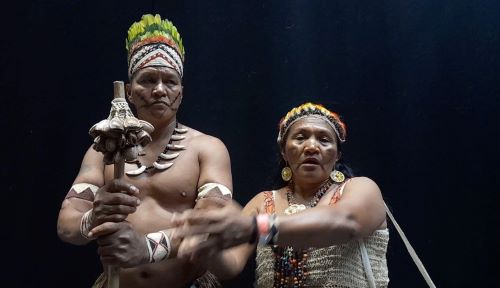
“… harmonizing the path, taking care of the tangible and the intangible of life…” “…preserving and taking care of nature, the relationship with the forest and with humanity… our dances clean the paths and the basis of thought ; the order of our dances is: opening the door, examining, evaluating and closing the door of each cycle… preparing to dance is like studying in the university (the maloca, the main house of the community)… when we study in the main houses, some become healers, others herbalists, others singers and dancers..”
Arhuaco or Iku people: 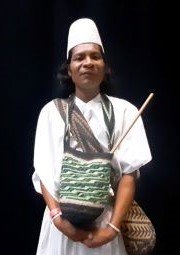 “… Dance exists to provide breath to all existing beings that give us life and feed us: the seed, the wind, the rain, Mother Earth… after dancing, the Earth feels happy, if we didn’t dance the world would be over…”
“… Dance exists to provide breath to all existing beings that give us life and feed us: the seed, the wind, the rain, Mother Earth… after dancing, the Earth feels happy, if we didn’t dance the world would be over…”
“Dance is daily life and the ritualization of special moments; according to their meanings some dances are developed; dance is not an event to show; it is a spiritual event that engages a deep work. Dances talk about the spiritual conception of what is human, the community and the Earth.” “We dance to balance the world, but we cannot do it alone. We need more people to learn our dances to give more force to the positive. Let’s dance the same dance of harmony; and it’s not that the negative is bad. The negative exists, it makes part of life, and it is disbalanced; therefore, a payment to the negative is made so that it has no hunger anymore and like this, we can dance to life from the positive…”
Embera people: 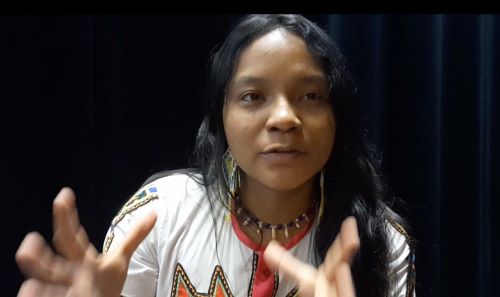
“… Embera dance is a manifestation of the ancestral knowledge of nature. Dance is beyond showing skills. It is first of all an offer, to food, to medicine, to animals and to plants; it activates the care and protection to keep knowledge alive. Our dance is a spiritual practice. The grandparents dreamt a union of forces where dance and spirituality are not separated and, like this, the grandparents’ word is accomplished; dances get together to heal the territory…”
Gunadule people: 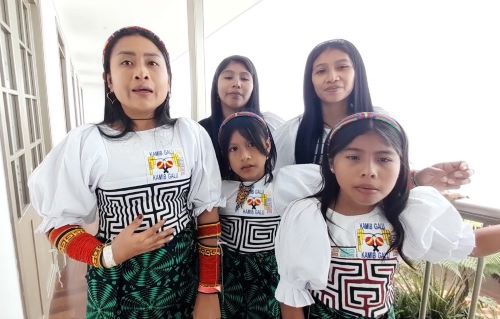
“… it establishes a bond with the mother. Decolonizing is not rejecting Spain or Europe. It is reestablishing the bond with Mother Earth, make possible for life to be in other forms, recovering the sacred, the magic and the spell; and this is not because of romantic idealisms but because of responsibility. … dance is decolonized when what lies behind the dance is revealed. Behind the original people’s dance there’s precise mathematics, rituality, and spiritual precision. That is why it has the power of healing us. The sacred dances that still exist have the millenary story of people…Dance in Gunadule means ‘being a child’…we must have two things clear: always be a child and remember that we come from a family. … being a child implies the continued disposition to learn… to dance, one hast to become a child, let yourself be, become dance, be dance. Dance becomes being. One does not dance just to dance, one dances because one is remembering… children learn with ease so there’s an opening to life, there’s listening, be a child to listen… to listen to the other you must be empty; if you are not empty you are not really listening; it’s not what you want to hear but it is about understanding what the other one is saying… we dance to thank Mother Earth, to listen to her, our own education consists of unlearning the patriarchal model to return to the education from Mother Earth… and moving the structures requires dance… Decolonizing is returning to the origins, but not the one of the original people but the origin of humanity; in the origin we are all the same; dance in the origin is spiritual and heals… transcend the shame of our bodies, remember paths… and taking care of the learnings that have brought meaning to life, taking care of the Earth, in a search for understanding her more and more…” Camëtšá people: 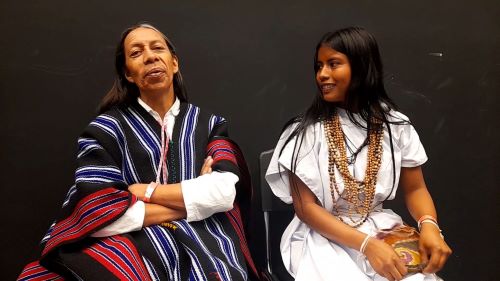
“… getting together to dance is an exchange of happiness… we celebrate with friends and relatives and many carry flowers in their heads to bless the dance, have a good day, and greet the new year giving and receiving dance and music… hugs, gratitude and friendship are danced until feeling the crying of happiness, spiritual gratitude and affection…” “One can dance in body and in spirit and sometimes only in spirit; if somebody is sick, the yajé (sacred plant from the Amazonas) medicine is given and with the ‘guaira’ (wind fan with medicinal leaves) her or his spirit is lifted and starts dancing to feel healthy and in balance again. Sickness brings dances that are meant to learn to heal.”
Mhuysqa people: 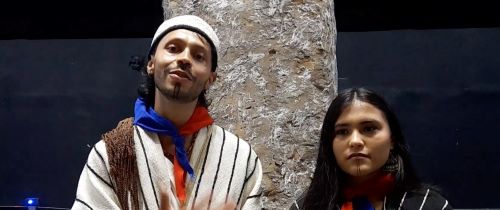
“…dance is the calling from the Earth, it is the: ‘we are here’…” “Dance unifies people; it is a process of revitalizing the territory… it is used to celebrate, it is a tissue in between generations, it connects us with the territory, the animals and the spiritual beings like the frog, which calls the waters with its singing and has the spiritual sense of taking care of the soul of the Earth…”
Muinane people: “… to clean and purify, this danced singing cleanses… after a war or fight, one dances ‘the dance of victory’, one collects what’s bad so that there’s no more war; …we search peace, harmony, and tranquility in the world…” Murui people: 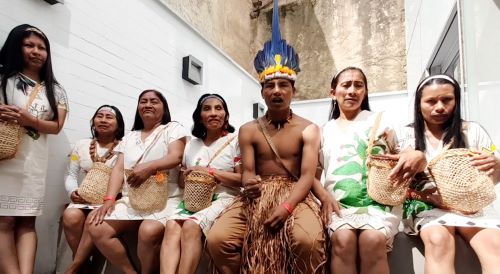
“…dancing for harmony, healing and balance… dance harmonizes because first of all dance is balance. It is said that balance is needed to dance and after dancing each person is more balanced than before and space is also balanced… dance is not something to do tricks with the body… dance is a prayer with the spirit through a balanced body… one dances to the enemy the dance of triumph (‘karijona’), when one does not want to fight anymore…” Wayuu people: 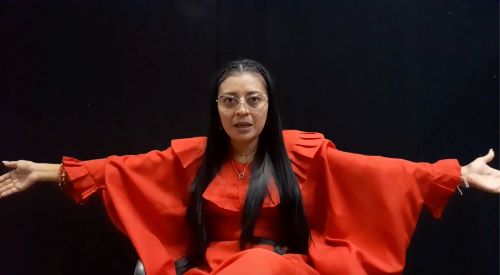
“… according to our ancestors, we dance to thank Mother Earth which feeds life; dance keeps us and preserves harmony and respect in each territory”. “Dance is moved by the forces of nature and, from there, she organizes.” “Dreams indicate us when it should be done; dreaming is sacred, it communicates us with the ancestors… if dreams are attended, life is organized; it is a relentless guide to which one dances…that’s why when we dance what we feel in the territory, it is peace; without ‘Yonna’ (the name of their dance) there’s no peace. Dance is a tool for peace”. Wiwa people: 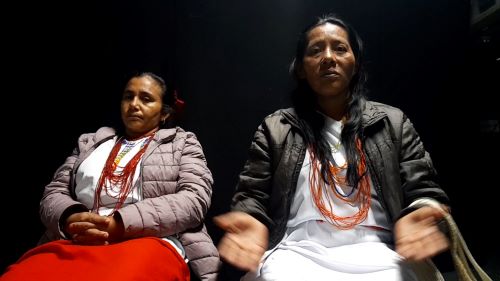
“… dance, as everything that exists, has a mother and a father. One dances to the mother and the father but one should not awaken them just for any reason; the oldest tell us why there’s going to be dance… dance for water is a precise dance, if dance is good water is good… dance is a work of exchange with the seeds, the food, the water, the wind, the earth, the birds, the people; every being that contributes with life deserves the return of life, and dance generates life and even more when the work of unity of the community is activated…” “…dance and collective creation come from ancestral communities; a collective creation respects the word of all and harmonizes it; rehearsals are done with the same seriousness than the final ceremony or show. If a dance is rehearsed too much, the creation can die, so each time that it is danced, it is ‘real’…” “… we dance to give force to the seed; if the seeds of people, plants, animals, thoughts and food are born with
force, they will live their lives with good force…”
The translations above are an attempt to communicate the ideas and feelings of the people that are talking. However, I must say that the difference of language and expressivity between their Spanish and my English is big. So, watching the interviews is recommended to have a closer grasping of the transmitted ideas. As I told you above, the original work is long, so I selected some passages that I find interesting, but there’s a lot more. These conversations make me think of the dozens of times I’ve been made the question about dance topics in the forum of contemporary-dance.org: ‘what to dance’, ‘topic for a dance’ or ‘ideas for a dance’…? What touches me in the content provided by the Colombian indigenous people is that their ‘themes’ are not just ‘themes’. The dances may be called with names, as if they were about a topic, but behind the names there’s always the echo of a relationship. I feel that their way of expressing the purpose of their dances shows their consciousness about their interdependence with nature, of course, but also in between them and between dance and everything that happens (or exists). Their words give me a taste of this ancient wisdom that is full of connection and humbleness: two values that we lack so much in the modern Euro-American urban culture. So, again… what do YOU dance for?...
Pueblo Muruy: https://youtu.be/4Xh1FdKeRJY Pueblo Wayuu Sabedor palabrero Joaquín : https://youtu.be/npw_U1gRrWs Pueblo Wayuu Sabedora y danzante Yari: https://youtu.be/Ck3TScVtYS0 Pueblo Wiwa Victoria Loperena: https://youtu.be/osHXyVl94PU Pueblo Wiwa Saga María Alberto: https://youtu.be/2vnYPEtzv54 Pueblo Miraña y Muinae Maloqueros Elvano y tránsito : https://youtu.be/8wGF10ijmCE Pueblo Iku y cametsa Hugo Jamioy y Ati Zalabeta: https://youtu.be/E2M2hAK4J0o Pueblo Gunadule Kamib Galu : https://youtu.be/V_0vm00UiLw Pueblo Gunadule Abadio Green: https://youtu.be/txQpiYoSCyw Pueblo Camëtsá Emerenciana Chujungue: https://youtu.be/8ljaKrmgeTE Pueblo Arhuaco: https://youtu.be/EoIlgNXNoIA Pueblo Embera: https://youtu.be/bXhOxUxw0qE Pueblo Mhuysqa: https://youtu.be/tVeORS5jcqk
https://www.facebook.com/eneldelia/videos/245017475100566 And here’s the link to the complete written report of the research: https://www.contemporary-dance.org/support-files/decolonialidad-biopoetica-de-la-danza-carolina-bejarano.pdf As always… I hope you find this useful, or yet better… meaningful. Till next time! María (Photo copyright of all pictures Carolina Bejarano)
That’s it for this issue. Remember that you can share your work through this e-zine too. Just contact me to discuss your ideas. Till next time. ;-)
Feel free to answer this e-mail. Let me know what you think. I’m always opened to comments, suggestions, ideas, wishes...
Editor and Webmaster of contemporary-dance.org
|
|||
| Back to Back Issues Page |